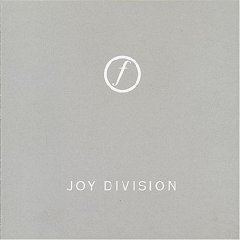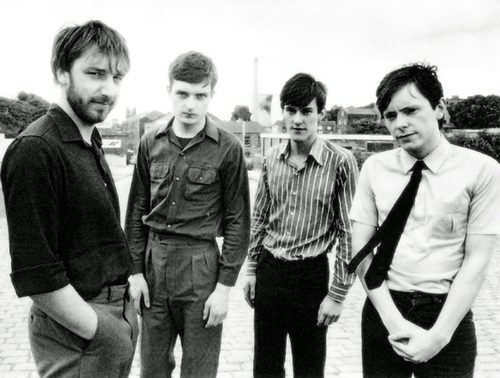Two of the most influential bands of the late 1970s- early 1980s were Manchester’s Joy Division and New Order. Two very different (yet not entirely dissimilar) bands who collectively account for ten albums, three EPS, and roughly 40 singles over the course of 27 years. For Popblerd’s latest edition of Note for Note, we examine the work of both bands, with today’s installment covering the Joy Division era.
Initially forming as Warsaw in 1976, Joy Division went on to issue just two influential, difficult-to-classify albums. Although there are elements of punk, the group is often labeled post-punk; some have labeled them as new wave, while others have burdened the band with the gothic albatross. This lack of easy classification is part of Joy Division’s continuing appeal, and is indicative that they were doing something musically unique. Guitarist Bernard Sumner (née Albrecht), bassist Peter Hook, drummer Stephen Morris, and vocalist Ian Curtis began playing together in 1976. Warsaw recorded an album for RCA, but quickly scrapped the project out of dissatisfaction with the album’s production. Following decades of bootlegging, the album was officially released in 1994, although many of tracks appeared on various Joy Division EPs and singles in the interim.
After abandoning their first major recording project, the band regrouped as Joy Division, whose recorded output spanned 1 EP, 2 LPs, and 5 singles within just over a year’s time. Following the suicide of lead singer and lyricist Ian Curtis, the band would call it quits, opting to initiate an entirely new project than to carry on Joy Division in some altered form.

Unknown Pleasures (1979)
Even if its success is largely retroactive, Joy Division’s debut is perhaps the most definitive artistic statement in the band’s brief catalog. Musically, the album shifts between more uptempo tracks highlighting the group’s punk leanings (“Disorder,” “Interzone”), songs focusing on a heavy, dark, lethargic aesthetic (“”Day of Lords,” “Candidate,” “I Remember Nothing”), and the spacious, midtempo, bass-driven sound with which they would become most associated (“New Dawn Fades,” “”Insight”).
Throughout these subtle variations, the lyrical tone is consistent. Curtis’ lyrics (buoyed by his characteristic vocal delivery) are dark, to say the least. The lyrics are very direct expressions of pain, death, emotional numbness, and overwhelming desire for seemingly unattainable escape or release. It’s not a particularly cheery album, to be sure. Yet there’s an undeniably raw emotion in Curtis’ delivery that as listeners, draws us in. Chris Ott absolutely nails it in describing Curtis’ lyrics as “crushingly honest.” Against the pulsating darkness Joy Division’s musical backdrop, these simple, direct, yet deeply affective lyrics make listeners feel the songs, to (however indirectly and in however limited a fashion) associate with the album’s emotional and psychological disclosure.
A notable standout track is “She’s Lost Control,” with it’s cold, mechanical pulse, frantic guitar runs, and Peter Hook’s repeating melodic bass motif. In a bizarre case of foreshadowing, Curtis wrote the lyrics about a girl who frequently visited the social center where he worked, often falling into epileptic seizures while at the center. The song is thus quite literally about losing control, as when one’s nervous system dissociates itself from voluntary control and acts on its own accord. This is eerily coincidental in light of Curtis’ own later battles with epilepsy.
Beyond the music, Unknown Pleasures‘ iconic cover art has taken a life of its own in popular culture, having graced skateboard decks, mini skirts, shoes (both on canvas, and soles) , nail art, and for at least one very brave and patient man, a wicked back tattoo. In a bizarre episode last year, Disney briefly sold t-shirts with a modified version of the cover that incorporated the famous silhouette of Mickey Mouse (Disney quickly pulled the shirts fearing litigation). The album cover is itself an appropriation of a pulsar drawing from the Cambridge Encyclopedia of Astronomy, so chalk one up for free culture, I suppose.
Grade: A+ (Gonzo)

Closer (1980)
For all intents and purposes, Unknown Pleasures is the quintessential Joy Division album. Even so, it’s follow up presents a no-less compelling set that was consistent with the band’s debut, but also saw them taking the next logical steps in their creative evolution. The music on Unknown Pleasures had a somewhat atmospheric quality, punctuated by tunes that appropriated the contemporary stylings of punk rock. On the whole, Closer is less ambient and more chaotic; fewer soundscapes and more straightforward rock; somehow darker but less brooding – some critics have appropriately called it claustrophobic. The dark and frenetic qualities of the music are likely reflective of Curtis’ worsening epilepsy, depression, and deteriorating marriage.
The album’s lyrical themes parallel these qualities; throughout, Curtis’ lyrics grapple with loss, isolation, sorrow, and uncertainty. While any of the songs could well be autobiographical, “Atrocity Exhibition” seems particularly so, a blunt commentary on the spectacle of others’ anguish. By this point, Curtis’ seizures grew more frequent and increasingly disrupted the band’s gigs – which many took as “part of the act.”
Unknown Pleasures may be the more widely known Joy Division record, but it and Closer are really two parts of a whole. That’s not to say that Closer doesn’t stand on its own – in the context of what else was happening musically in 1980, the album has few peers that are as compelling musically, lyrically, and emotionally. The album would also be the band’s last, as Ian Curtis took his own life months before its release.
Grade: A- (Gonzo)

Still (1981)
Released just one month ahead of New Order’s debut, Still packaged unreleased Joy Division material across two discs. The bulk of the album presents the first official document of Joy Division’s live act, culled from two 1980 performances. The quality of the live material varies, with the Birmingham University material sounding closer to a decent audience recording than a professionally recorded set. The live portion of Still is especially notable for containing the band’s sole performance of “Ceremony,” a song that effectively bridged the transition from Joy Division to New Order.
The real attraction here however, are the nine studio cuts, recorded at various sessions from 1978-1980. Given the timespan, Still‘s studio tracks cover Joy Division’s various stylistic modes. “Dead Souls” is the standout track, which would gain a new audience via Nine Inch Nails’ cover in the 1994 film The Crow.
Grade: B+ (only because I find the live material somewhat inessential – Gonzo)
.jpg)
Substance (1988)
This is the rare example of a compilation record, not only worthy of inclusion in, but a mandatory part of a bands discography. Falling in the middle-ground between a greatest hits and a rarities collection, this is 17 tracks of essential Joy Division. The CD collects four non-album singles, their B-sides, and an assortment of tracks previously issued on EPs and samplers. There is minimal overlap with the two studio albums – with “She’s Lost Control” being the only song revisited – and even that is an alternate take to what appears on Unknown Pleasures. To put it simply, without this record, you’re really only getting half of the Joy Division story.
Running from Joy Division’s earliest recordings right through to some of their final works, Substance does what so few retrospectives achieve – it presents a realistic outline of the band as they existed. While not always cohesive, it’s an expression of Joy Division’s depth as a group and Curtis’ song writing genius. Tracks from their debut release An Ideal for Living are a far cry from the band they would become, but represent an indispensable part of the catalogue to completists. The inclusion of two of their most popular and accessible songs “Digital” and “Transmission,” alongside THE definitive Joy Division single “Love Will Tear Us Apart” make Substance an equally appealing jump on point for new listeners. “Dead Souls” also present here, is from a personal perspective, the best moment of the group’s short history. This is the album which completes your Joy Division collection – the necessary companion piece to Unknown Pleasures and Closer.
For Further Information:
If you want to cover your bases, go for the Heart and Soul boxed set. It doesn’t have everything, but its four discs boast both studio LPs, singles, live cuts, 12″ mixes and more.
Chris Ott’s 33 1/3 book on Unknown Pleasures is an excellent examination of the album, and does great job of contextualizing Joy Division’s debut within the group’s broader trajectory, and Ian Curtis’ personal struggles.
Bassist Peter Hook recently published a memoir by the same name, which focuses exclusively on the Joy Division years.
Anton Corbin’s 2007 Curtis biopic Control does an excellent job of presenting the singer’s life, death, struggles, and music for the big screen.


